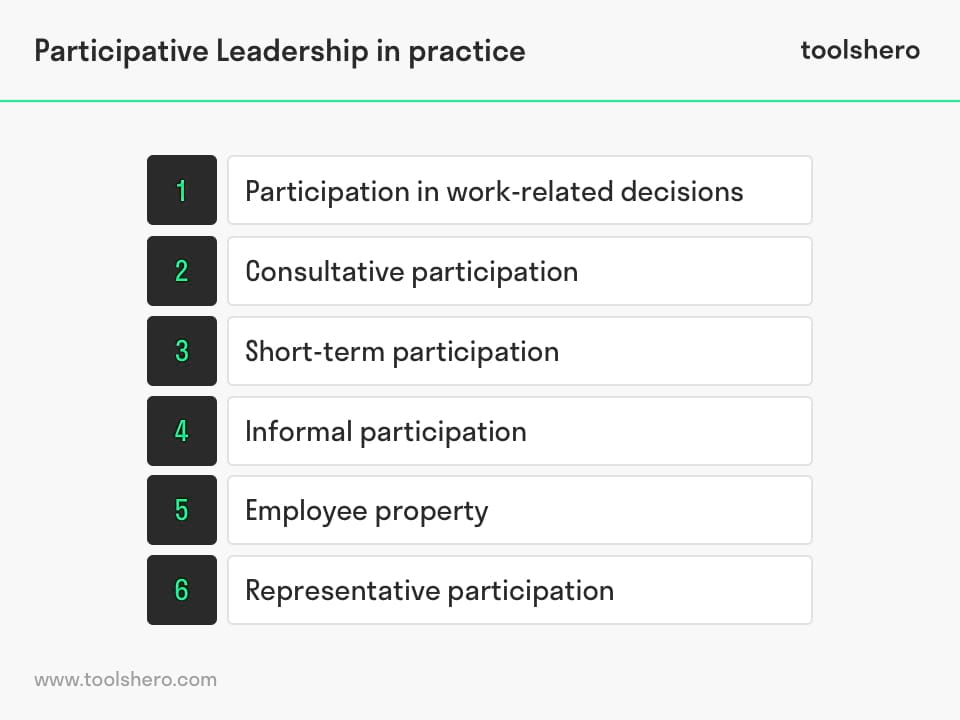Participative Leadership Style

Participative Leadership: this article provides a practical explanation of participative leadership. Next to what it is, this article also highlights the rise of this leadership style,the decision making and this leadership style in practice. After reading, you’ll understand the basics. Enjoy reading!
What is the Participative Leadership style?
The Participative Leadership style is one of the four leadership styles from Rensis Likert Management System. This style of leadership is also referred to as democratic leadership.
Participative Leadership is characterised by the leader actively involving team members in identifying objectives, developing strategy, and decision-making in general. This leadership style is often used in volunteering, social work, and by therapists. In the business world, however, this style is not as popular.
Exactly how the manager participates in the team depends on which form of Participative Leadership is applied.
Generally speaking, at the core of this leadership style is that the manager often actively asks for feedback and uses this input for future decision-making. This can be done in several different ways, however.
The Rise of Participative Leadership
The first leadership theories emerged around 1930, when an experiment called Hawthorne took place. The experiment was intended to improve productivity in the workplace. The results were studied by Elton Mayo, among others. Henry A. Landsberger then discovered that productivity would be higher if employees were closely observed. This was referred to as the Hawthorne-effect.
Later, in 1967, Rensis Likert and his colleagues identified the foundation for later leadership theories. After more than 30 years of research, the following leadership styles were eventually formulated:
- Exploitative Authoritative
- Benevolent Authoritative
- Consultative
- Participative
Eventually, the basic concepts and theories on Participative Leadership came to the fore. This leadership style refers to the idea that objectives can be more easily achieved if everyone collaborates and is involved in decision-making. When linking leadership to this notion, it appears that there are different ways of distinguishing of this leadership style.
Decision Making in Participative Leadership
Although a clear definition of Participative Leadership is elusive, there are four different types that have been identified on the spectrum of little to much participative leadership behaviour.

Figure 1 – 4 types of Participative leadership styles
Collective Participative Leadership
The collective Participative Leadership style is at one end of the spectrum. In this leadership style, the leader and group collectively take all decisions. In this approach, responsibility is also divided among each member of the group.
Democratic / Participative Leadership
In this style, employees are encouraged to share their opinion and vision about matters. However, the eventual decision-making power lies with the leader. The leader holds all responsibility for the decision to be made. Moreover, he / she is also the person that must provide an explanation in case of unsatisfactory results. In this style, the leader makes the effort of removing concerns from stakeholders by presenting them to the group.
Autocratic Participative Leadership
With very little participation from the manager, the autocratic Participative Leadership style is on the left side of the spectrum. Although final decision-making power is in the hands of the leader, input from employees, or subordinates, is still listened to.
Consensus Participative Leadership
In this decision-making style, the leader lets the group make decisions together. This is often done by a vote, after which the majority’s preference is chosen.
Participative Leadership in Practice
The use of Participative Leadership is not equally effective in all industries. Nevertheless, this form of leadership is popular, and has been the subject of plenty of research throughout the years.
A participative leadership style in practice is mainly expressed by the following dimensions, as established in research by John Cotton.

Figure 2 – Participative leadership examples in practice
Participation in Work-related Decisions
This first dimension is about participation of subordinates in decision-making related to the work. Having a voice in decision-making can take on different forms. For example, sometimes employees are only involved or interviewed; other times a certain amount of power is actually handed to them.
This approach to this leadership style is often applied in project management, when the manager discusses in advance how and when certain goals and interim results must be achieved.
In this situation, team members are given the opportunity to share their input, and thus have partial control over agreements made in this regard. On the other hand, the project manager has complete control over the project’s finances.
Consultative Participation
Consultative participation generally implies that subordinates participate in various business activities. The person who ultimately makes the decision remains the leader, but in almost all areas the subordinates are asked to share their opinion and vision. They generally have less influence in the final decision-making process, however.
Short-term Participation
In this dimension of Participative Leadership, subordinates are only temporarily involved in decision-making and operational management.
This short-term participation uses a formal structure and direct participation framework. An example of this form of participation is when an organisation introduces a new project, and has an existing team perform the start-up phase.
This is usually for a short period, after which decision-making power is returned to the project leader.
Informal Participation
The above forms all have a formal nature. However, participative leadership may also occur in less formal settings. A typical informal setting or situation has no set rules or procedures.
Instead, everything is evaluated and addressed on the spot. An example is a planned manager meeting, in which he/she informs his/her employees of upcoming changes or bad news, for example.
Employee Property
In the employee property dimension, subordinates can participate in certain elements of company decision-making, although the degree to which they can depends on each employee’s position.
Generally speaking, employees in a lower position have fewer opportunities to participate in direct management or decision-making than colleagues in a higher position.
Representative Participation
Representative participation refers to a formal structure and three-level participation framework. First there is the leader, then the representative, and finally employees. The representatives have the authority to give advice and influence the organisation’s decision-making process. They do this on behalf of the employees.
Many organisations employ so-called middle managers for this position. These act as messengers between management and employees. Before a decision is made, these middle managers, or representatives, may consult employees and provide input to management.
Now it’s your turn
What do you think? Are you familiar with the explanation about participative leadership? When do you believe participative leadership is appropriate? What are the pros and cons of this leadership style in different situations? Do you have any tips or additional comments?
Share your experience and knowledge in the comments box below.
More information
- Bass, B. M., & Stogdill, R. (1981). Handbook of leadership. Theory, research, and managerial.
- House, R. J., & Mitchell, T. R. (1975). Path-goal theory of leadership (No. TR-75-67). WASHINGTON UNIV SEATTLE DEPT OF PSYCHOLOGY.
- Huang, X., Iun, J., Liu, A., & Gong, Y. (2010). Does participative leadership enhance work performance by inducing empowerment or trust? The differential effects on managerial and non‐managerial subordinates. Journal of Organizational Behavior, 31(1), 122-143.
- Somech, A. (2005). Directive versus participative leadership: Two complementary approaches to managing school effectiveness. Educational administration quarterly, 41(5), 777-800.
How to cite this article:
Janse, B. (2019). Participative Leadership Style. Retrieved [insert date] from Toolshero: https://www.toolshero.com/leadership/participative-leadership-style/
Original publication date: 08/28/2019 | Last update: 06/30/2023
Add a link to this page on your website:
<a href=”https://www.toolshero.com/leadership/participative-leadership-style/”> Toolshero: Participative Leadership Style</a>












